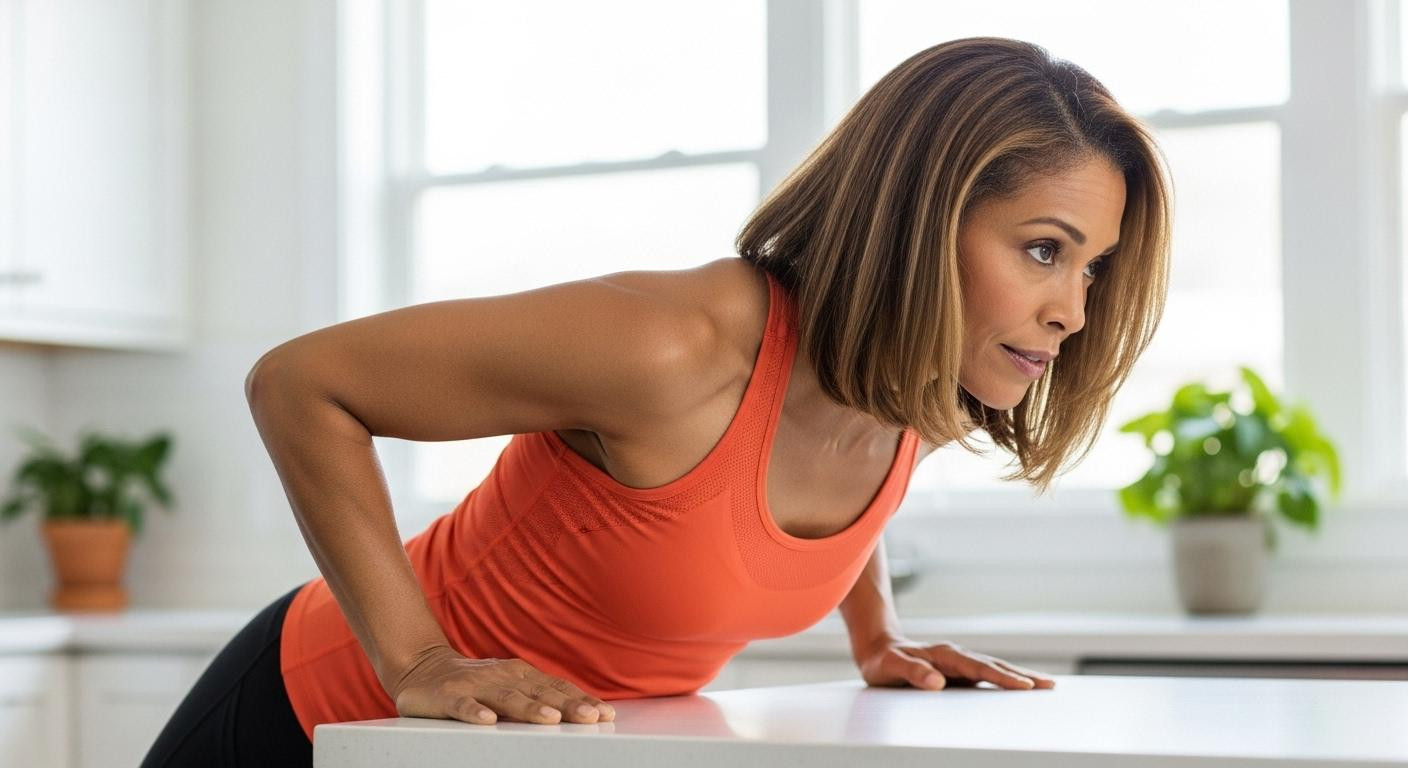At 53, fitness feels different than it did at 33. Your body demands smarter training, not harder. As a certified personal trainer experiencing midlife firsthand, I’ve discovered that ten-minute full-body workouts deliver maximum results when designed specifically for women navigating hormonal shifts and time constraints. Four sessions weekly preserve muscle mass, bone density, and metabolism more effectively than hour-long gym sessions. This isn’t about shortcuts. This is about scientific precision meeting real-life demands.
Why midlife demands a different fitness approach
Women over 45 lose 3-8% of muscle mass per decade. Post-menopause accelerates this decline dramatically. Bone density drops 1-2% yearly without resistance training intervention. Your metabolism slows by approximately 10% each decade after age 30.
Traditional hour-long cardio sessions can’t combat these biological realities. Research demonstrates that short-duration strength training matches longer sessions for metabolic benefit. Certified personal trainers specializing in women’s midlife fitness confirm that intensity trumps duration for muscle preservation.
Time constraints intensify during these years. Caregiving responsibilities, career peaks, and sandwich generation pressures make consistency more valuable than perfection. A sustainable ten-minute routine beats an abandoned hour-long program every time.
The 10-minute full-body workout breakdown
This protocol follows a 40-second work, 20-second rest format. Each exercise targets multiple muscle groups simultaneously. The elevated heart rate creates metabolic stress equivalent to longer sessions through sustained EPOC effects.
Core exercises and why they matter
Modified squats build functional strength for daily activities. Chair-assisted versions accommodate joint limitations while maintaining muscle activation. Sumo squats target glutes and inner thighs more effectively than traditional positioning.
Plank variations strengthen core stability to prevent back pain. Standard planks work for 45 seconds with modification options available. Alternative movements include modified planks using kitchen counters for those unable to maintain floor position.
Dumbbell rows correct forward head posture common in midlife women. Low-impact rowing movements load bones safely while building upper body strength. Bent-over and upright row combinations target different muscle fiber patterns.
Equipment you actually need (and what you don’t)
Start with 2-3 pound dumbbells if you’re a beginner. Progress to 5 pounds as strength improves. Advanced trainees can use 8-10 pound weights for challenging resistance.
Budget alternatives include water bottles filled with sand or water. Resistance bands cost $5-15 and provide variable resistance. Compare this to gym memberships averaging $50-100 monthly. Initial equipment investment pays for itself within three months.
No special flooring or dedicated space required. A 6-foot by 6-foot area accommodates all movements. Kitchen counters substitute for exercise benches when needed.
Science-backed benefits specific to women in midlife
Resistance training prevents the 3-8% muscle loss rate typically experienced after age 30. Four weekly sessions maintain existing muscle mass while building functional strength for everyday activities.
What happens to your body after 4 weeks
Functional improvements appear within 2-3 weeks. Stair climbing becomes easier. Grocery bag carrying no longer requires multiple trips. Sleep quality improves through regulated cortisol patterns.
Bone density improvements begin immediately through osteoblast activation. Weight-bearing exercises signal bones to maintain calcium deposits. Evening strength sessions specifically target metabolic enhancement during hormonal fluctuations.
Metabolic elevation persists for 24-48 hours post-workout through EPOC effects. This afterburn phenomenon increases calorie expenditure even during rest periods.
The neurological advantage nobody talks about
Strength training enhances cognitive function through BDNF production. Research from 2025 links resistance exercise to reduced dementia risk in women over 50. Regular training improves focus and mental clarity during hormonal transitions.
Endorphin release during resistance training regulates mood more effectively than cardio alone. Gentle strength movements provide psychological benefits without overwhelming joint systems.
Making it sustainable beyond motivation
Schedule sessions during your highest energy periods. Morning workouts capitalize on cortisol peaks for enhanced performance and adherence. Evening sessions work better for some women depending on circadian rhythm preferences.
Track functional improvements rather than aesthetic changes. Document how many grocery bags you can carry or flights of stairs you climb without fatigue. These metrics matter more than scale numbers.
Home-based routines eliminate travel time and gym intimidation. Social media communities provide accountability through shared experiences and progress celebrations.
Your questions about midlife fitness and 10-minute workouts answered
Can 10 minutes really replace hour-long gym sessions?
Yes, with proper intensity and exercise selection. Four weekly sessions provide sufficient stimulus for muscle preservation and metabolic enhancement. This approach prioritizes maintenance over maximum muscle building. Marathon training requires different protocols, but general fitness and strength preservation work perfectly with this timeframe.
What if I have joint issues or haven’t exercised in years?
Chair-assisted modifications accommodate most limitations. Water bottles replace dumbbells for ultra-light resistance. Wall push-ups substitute for floor versions. Always start lighter than you think necessary. Progression happens naturally over 4-6 weeks with consistent practice. Consult healthcare providers for chronic condition guidance.
How quickly will I see results?
Functional strength improves within 2-3 weeks of consistent training. Visible muscle tone changes appear around 6-8 weeks. Energy levels and sleep quality improve immediately. Focus on how you feel rather than appearance changes. Strength gains precede visible muscle development in this age group.
Picture yourself hiking that postponed trail without stopping for breath every quarter-mile. Visualize lifting luggage into overhead bins without wincing or asking for help. Imagine keeping pace with energetic grandchildren at playgrounds. This isn’t nostalgia for your thirties. This is your fifties done right, ten focused minutes at a time.
